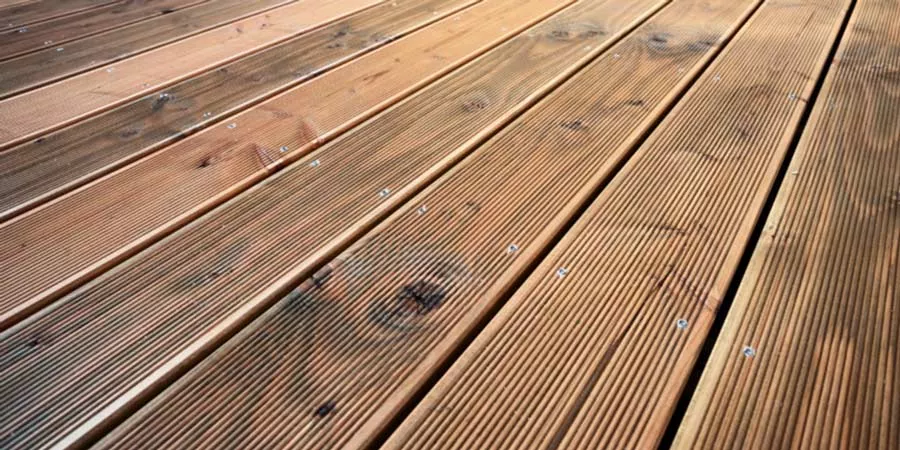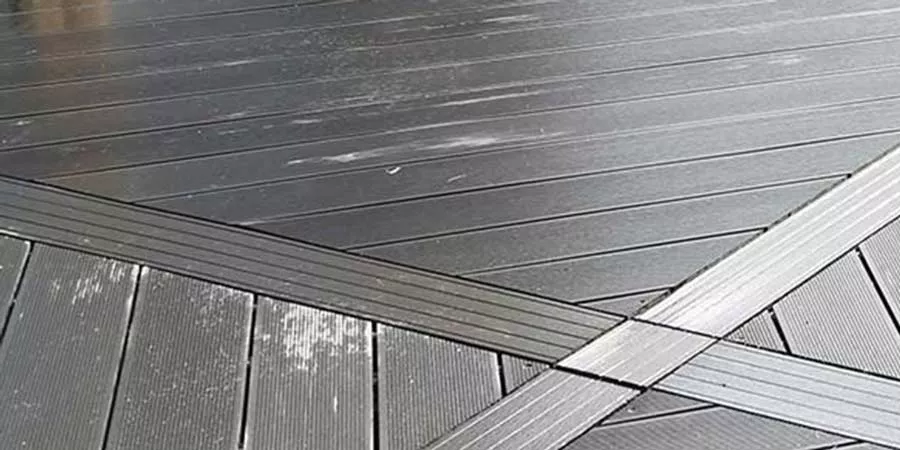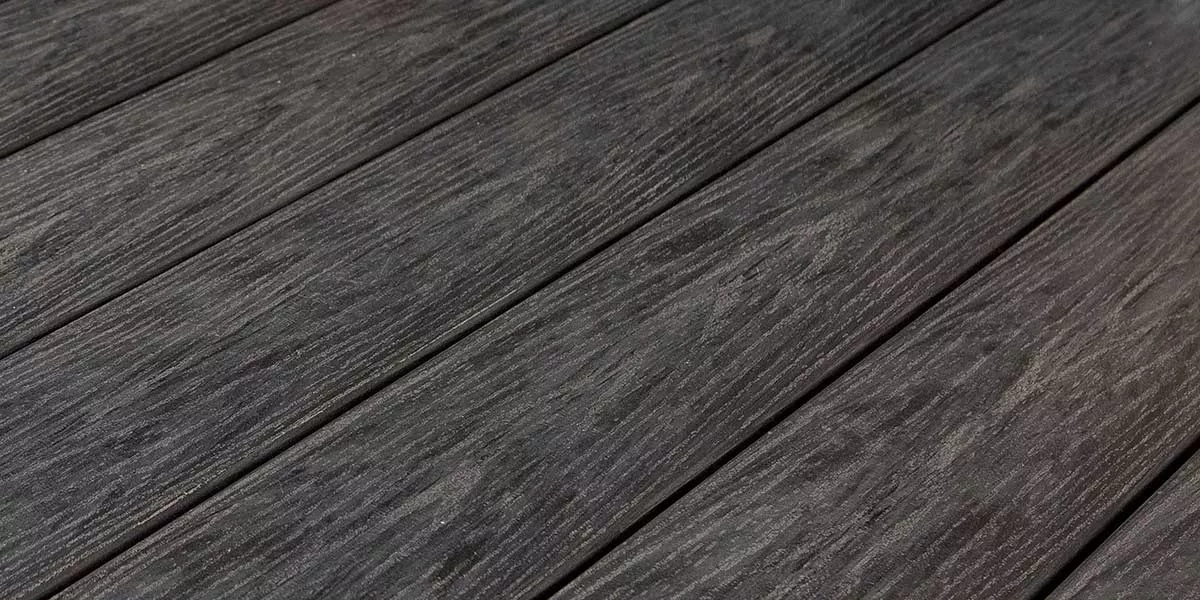When purchasing new decking for your home you will need to choose between three different types of material for the decking. When looking at UPVC vs wood vs composite decking, it’s useful to know the pros and cons of each material before you decide whether UPVC, wooden or composite decking best suits your requirements.

UPVC decking is a modern and versatile option for outdoor spaces, made from unplasticized polyvinyl chloride. This material is known for its durability, low maintenance, and long-lasting performance, making it an attractive alternative to composite or wood decking. Unlike wood, it does not rot, warp, or splinter, and it requires minimal upkeep, often only needing occasional cleaning.
Decking made from UPVC offers a wide range of colours and finishes that mimic the natural look of wood, providing aesthetic appeal without the associated maintenance challenges. This makes it a popular choice for homeowners seeking a durable and hassle-free decking solution.
What is UPVC Decking?
Crafted from unplasticized polyvinyl chloride, decking made from UPVC presents homeowners with a remarkably durable and low-maintenance alternative to both wood and composite decking. Engineered to endure harsh weather conditions and heavy foot traffic without degradation, it offers reliability in every step. With a range of colours and finishes closely mirroring the natural wood look, UPVC decking delivers aesthetic versatility alongside its longevity and effortless upkeep. These qualities establish it as the preferred choice for individuals in search of a practical and visually appealing decking solution.
What is Wood Decking?
Wood decking, renowned for its natural beauty and welcoming appearance, remains the traditional option favoured by many. Its timeless aesthetic effortlessly complements various home styles. Nevertheless, the drawbacks often overshadow its benefits, as wood decking demands consistent maintenance to mitigate issues like rotting, warping, and splintering. Essential treatments such as staining, sealing, and routine cleaning are imperative to uphold its appearance and lifespan.
What is Composite Decking?
Crafted from a blend of wood fibres, plastic, and other components, composite decking is engineered to emulate the look of wood while providing heightened durability and reduced maintenance demands. Resistant to both rot and the elements, it stands as a durable choice for outdoor settings. However, its longevity falls short of a similar deck made from UPVC, as it may occasionally succumb to fading and scratches.

UPVC Decking: Pros and Cons
Pros
Slip-resistance: It is designed to be slip-resistant, providing a safe walking surface in all weather conditions. This is particularly beneficial for homes in rainy climates like the UK.
Rot-free: It is completely immune to rot and decay, making it a highly durable option that can last for decades without deteriorating. This durability ensures a long lifespan and reduces the need for replacements.
Environmentally friendly: It is manufactured using recycled materials and is recyclable. This makes it an eco-friendly choice for environmentally conscious homeowners who want to reduce their carbon footprint.
Zero maintenance: It requires virtually no maintenance beyond occasional cleaning. Unlike wood, it does not need staining, sealing, or painting, saving time and money on upkeep.
Cons
Slightly more expensive: The cost can be more expensive than wood and some composite options. However, its durability and low maintenance needs often justify the higher upfront cost.
Wood Decking: Pros and Cons
Wooden decking can very quickly leave your garden looking spectacular, but it can be costlier than most decking materials. It is also susceptible to rotting, warping and splintering which can leave it looking tired, so you may have to go to the trouble of replacing it after a few short years.
Pros
Natural appearance: Wood decking offers an authentic, warm look that blends seamlessly with natural surroundings, enhancing the beauty and value of any outdoor space. The unique grain patterns and rich colours of wood provide a timeless and classic aesthetic that many homeowners are drawn to.
Inexpensive to buy: Initially, wood decking can be more affordable than other materials. This lower upfront cost makes it an accessible option for many homeowners, especially those looking to enhance their outdoor areas on a budget.
Cons
Prone to splitting, Cracking, and Losing Its Colour: Untreated wood is vulnerable to weathering and can deteriorate quickly when exposed to the elements. Without regular maintenance, wood decking can split, crack, and fade, leading to a shorter lifespan and a less attractive appearance.
Ages quickly: Wood naturally weathers and ages over time. Exposure to sunlight, moisture, and temperature fluctuations can cause wood decking to lose its original beauty and structural integrity faster than synthetic materials.
High maintenance: To keep wood decking looking its best, it requires frequent maintenance, including yearly varnishing, staining, and treating. This ongoing care can be time-consuming and costly.
Slippery when wet: Wood decking can become very slippy when wet, posing a safety hazard. Moisture can also promote the growth of mould and algae, further increasing the risk of slips and falls.
Composite decking: pros and cons
Composite decking consists of several materials, including an element of plastic, wood and polymer. If you’re looking at composite or wood decking, it’s important to note that the combination of these materials gives composite decking a similar appearance to authentic wooden decking and the moisture-resistant qualities of decking made from UPVC. Though it has a tendency to sag and bend more predominantly than a premium hardwood deck, this is alleviated by bringing the joists on the subframe closer together.
Pros
Slip-resistant material: Composite decking is designed to be slip-resistant, providing a safer surface for walking, even when wet. This makes it a practical choice for families with children or elderly members.
Wood-like appearance: High-quality composite decking can closely mimic the look and feel of natural wood, offering a visually appealing alternative without the drawbacks of expensive and time-consuming wood maintenance.
Rot-free: Unlike wood, composite decking is impervious to rot, decay, and insect damage. This makes it a durable and long-lasting option that can withstand various environmental conditions.
Simple to install: Composite decking is often designed for easy installation, with many systems featuring interlocking boards and hidden fasteners. This can simplify the installation process and reduce labour costs.
Cons
Can feel extremely hot underfoot: Dark-coloured composite decking can absorb heat from the sun, making it uncomfortable to walk on during hot weather. This can limit its usability when the sun makes an appearance. Considering most people prefer to use their decking when it is hot and sunny, this is a big factor to consider.
Susceptible to scratches: Although durable, composite decking can be prone to scratching from heavy furniture, pet claws, and other abrasive objects. These scratches can be difficult to repair and may affect the deck’s appearance over time.
Can sometimes fade: Over time, exposure to sunlight can cause the colour of composite decking to fade. While high-quality products are designed to resist fading, it can still occur, affecting the deck’s aesthetic appeal.

Cost Overview of Decking Solutions
Wooden decking typically has the lowest upfront cost, making it an attractive option for budget-conscious homeowners. Composite decking comes next, with a higher initial price due to its blend of wood fibres and plastic. UPVC decking has the highest upfront cost, which reflects its durable, low-maintenance materials.
The latter is somewhat more costly in the short-term, but in most aspects, it can be considered more cost-effective than other forms of decking because of the fact that it lasts much longer and needs very little care.
Initially, the wood is cheaper to buy or install, and it can be tempting to choose this for that reason, but in the long run, wood decking needs almost constant maintenance to make sure it does not deteriorate beyond repair.
Why UPVC Decking is the Best Solution
It stands out as the best solution amongst the three options of UPVC vs composite vs wood decking. Its long-term value is unmatched, as it is designed to last for decades without deteriorating.
It is virtually maintenance-free, needing only occasional cleaning to keep it looking pristine. Its rot-free and slip-resistant properties ensure safety and durability, even in harsh weather conditions.
While the initial UPVC decking cost may be higher, the savings on maintenance and replacement makes it the most cost-effective and hassle-free option in the long run.
Don’t be put off by the price of a UPVC deck as it is only slightly more expensive than a composite deck, and in any case, Lakeland Verandahs is able to offer you a number of flexible finance options to help you pay for it. Remember too that a UPVC deck has a long lifespan, so you will get full value for money from it.